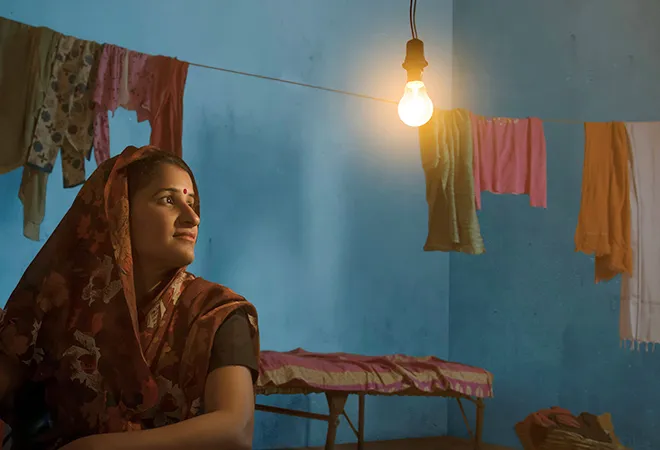
In 2011, only 55% of rural households in India were electrified (Census of India, As on February 2020). This percentage by now has increased to almost 100%. Traditionally the
un-electrified households used to depend on kerosene lamps for illumination after sunset. Home based renewable energy (RE) solutions (such as solar lanterns, solar home lighting systems, solar torches) were introduced and promoted to provide quality and clean illumination to the rural households. Various models for promotion/dissemination and maintenance of these home based RE systems were adopted by the government and other civil society organizations. Many of these institutional models required and encouraged rural women to take more proactive roles in terms of ground level implementation. For example; The Energy and Resources Institute (TERI) engaged many rural women as entrepreneurs for Lighting a Billion Lives
<1> (LaBL) programme, Barefoot College implemented their business model with rural women as the primary agents for change
<2>.
There are also small scale community based renewable off grid plants such as solar micro/mini/small grids, and micro hydels. These systems were mostly installed by the developmental organizations or governments, with institutional models which in many instances involved women in decision making and other roles like awareness creation, maintenance, tariff collectors or marketing agents. In the rural localities, where now power is available for 18-20 hours in a day, the end users prefer inverters over home based renewable energy solutions.
<3> In the rural electrified households with unreliable supply of conventional power, the role of home based renewable energy (RE) solutions has reduced as back up support during power cuts. With this, the role of women (and women groups) in promotion, management and maintenance of RE based household systems and off-grid power plants is also reducing. However, a few studies have been being conducted to identify the role of women in clean energy access . For example, in the year 2018 UNWOMAN conducted a survey in 100 villages across four states in India and mentioned that women are well situated to create community awareness about clean energy systems as they hold strong social capital (UNWOMAN, As on February 2020) .
On the other hand, the space of grid interactive renewable power is increasing. Today, the total installed electricity generation capacity of India is about 366 Gigawatts (GW) and 23% of this, about 84 GW, is from Renewable Energy Sources (RES) (Ministry of Power, as on January 2020). India showed significant growth in renewable based installed capacities in the last decade. The Compound Annual Growth Rate (CAGR) for installed generating capacity in electricity from 2008-2018 using RES stands at 18% (Ministry of Statistics and Programme Implementation, 2019). The Renewable Energy (RE) targets and the trends altogether show a promising future for grid interactive renewable power in India, and thus enhanced job opportunities.
The home based RE systems and off-grid power plants were engaging rural women in various roles. Will the expanding space of grid interactive renewable power be able to engage the rural women as the RE based off-grid power plants and households systems used to do? International Energy Agency (IEA) provided figures for solar rooftop companies in India. The study indicates that the share of female employees in office-based positions (such as design & pre-construction phase) and corporate segment is 18% and 34%, respectively (IEA and CEEW, 2019). In the area of construction and commissioning (where lesser educated and semiskilled rural women may be engaged) women constitute 3%, and, in operations and maintenance, a mere 1%.
The matrix below consolidates the conventional role of rural women, who generally are unskilled or semiskilled, in the RE based systems.
Table 1 Participation level of the rural women in RE space and utility level of RE based solutions (stand alone, off-grid & grid interactive) at different levels of rural electrification status
|
Un-electrified households |
Electrified households with unreliable power supply |
Electrified households with reliable power supply |
| RE based household systems/ off grid power plants |
Utility level of the RE system |
Primary source of quality illumination |
Back-up during power cuts |
|
| Rural women participation |
Entrepreneurs, Awareness creators, Marketing agents as part of social marketing strategies, Managers, Operators |
|
| Renewable based grid interactive power plants |
Utility level of the RE system |
|
Power is supplied to the main grid |
| Rural women participation |
|
Jobs based on individual’s education and skill level |
Source: Author
<4>
The matrix indicates the diminishing participation of rural women in the RE sector with reducing space of RE based household/community systems due to enhanced and increasing access to household electrification. This change in rural electrification status is required and is taking us towards the Sustainable Development Goal (SDG) 7 which ensures affordable and clean energy to all. Along with the progress in rural electrification status and the shifting scenario for renewable energy it is important to retain the participation of our rural women in the RE space. One way is to identify and impart skills to rural women to attain gainful employment in the grid connected RE as well. RE companies may be encouraged to provide intern and apprentice opportunities to the willing rural women with a view to providing them a boost towards their ultimate employment. These skill based jobs in RE has the potential to engage women with limited educational qualifications.
India as a leader of the International Solar Alliance (ISA) and with huge targets for RE has much more promising options to enhance participation of women in increasing RE capacities. Skill development has been a major initiative of the government of India . At the national level, governmental bodies such as the National Institute of Solar Energy (NISE) and Skill Council for Green Jobs are being established. Now, it is the time for enhancing gender inclusion in these skill development initiatives at various levels of RE implementation including for the projects of Megawatt scale. National skilling goals may introduce specific targets for rural women to be skilled across the complete spectrum of RE.
References:
Census of India. (As on February 2020).
IEA and CEEW. (2019).
Women Working in the Rooftop Solar Sector: A Look at India's Transition to Clean Energy.
Ministry of Power. (as on January 2020).
Ministry of Statistics and Programme Implementation. (2019).
Energy Statistics 2019. Government of India, New Delhi. Retrieved January 2020
UNWOMAN. (As on February 2020).
<1> http://labl.teriin.org/
<2> https://www.barefootcollege.org/
<3> Based on author’s interaction with the rural communities
<4> Based on author’s interaction with rural communities and desk research
The views expressed above belong to the author(s). ORF research and analyses now available on Telegram! Click here to access our curated content — blogs, longforms and interviews.



 In 2011, only 55% of rural households in India were electrified (Census of India, As on February 2020). This percentage by now has increased to almost 100%. Traditionally the un-electrified households used to depend on kerosene lamps for illumination after sunset. Home based renewable energy (RE) solutions (such as solar lanterns, solar home lighting systems, solar torches) were introduced and promoted to provide quality and clean illumination to the rural households. Various models for promotion/dissemination and maintenance of these home based RE systems were adopted by the government and other civil society organizations. Many of these institutional models required and encouraged rural women to take more proactive roles in terms of ground level implementation. For example; The Energy and Resources Institute (TERI) engaged many rural women as entrepreneurs for Lighting a Billion Lives
In 2011, only 55% of rural households in India were electrified (Census of India, As on February 2020). This percentage by now has increased to almost 100%. Traditionally the un-electrified households used to depend on kerosene lamps for illumination after sunset. Home based renewable energy (RE) solutions (such as solar lanterns, solar home lighting systems, solar torches) were introduced and promoted to provide quality and clean illumination to the rural households. Various models for promotion/dissemination and maintenance of these home based RE systems were adopted by the government and other civil society organizations. Many of these institutional models required and encouraged rural women to take more proactive roles in terms of ground level implementation. For example; The Energy and Resources Institute (TERI) engaged many rural women as entrepreneurs for Lighting a Billion Lives PREV
PREV


